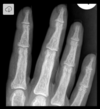Hypo & Hypercalcaemia Flashcards
(65 cards)
What range of calcium suggests hypercalcaemia?
Serum > 2.6 mmol/l
Commonest causes of hypercalcaemia.
Primary hyperparathyroidism
Malignancy
How can one distinguish between primary hyperparathyroidism and malignancy?
Primary hyperparathyroidism is associated with normal or high PTH
Malignancy will be associated with a low PTH
What is hypercalcaemia with suppressed PTH until proven otherwise?
Malignancy
Which malignancy is usually the cause of hypercalcaemia?
Squamous cell epithelial tumours of the lung due to the secretion of PTH-rP
However rarely lymphoma can also cause hypercalcaemia.
In what stages of malignancy does hypercalcaemia usually present?
In large or advanced tumours.
Bony metastases are not always present.
When other than in malignancy might hypercalcaemia with a low PTH present?
Benign granulomatous disease such as TB or sarcoidosis
What is hypercalcaemia with non-suppressed PTH until proven otherwise?
Primary hyperparathyroidism
What is primary hyperPTH usually caused by?
A single parathyroid adenoma
What does parathyroid hyperplasia in more than one gland suggest?
Genetic cause such as multiple endocrine neoplasia.
It can also be present in CKD due to secondary hyperPTH, however calcium levels will be low in this case.
What might a very high serum calcium > 3.5 mmol/l with a large parathyroid tumour indicate?
Parathyroid cancer.
This is very rare
What might parathyroid cancer rarely occur in association with?
Jaw tumours
This is called Hyperparathyroidism-jaw tumour syndrome.
Most common clinical presentation of primary hyperPTH.
Often asymptomatic and discovered incidentally during routine blood tests.
Give examples of non-specific symptoms of hypercalcaemia.
Tiredness
Generalised aches and pains.
Specific symptoms of hypercalcaemia.
Polyuria
Polydipsia
Nephrogenic DI
Other symptoms of hypercalcaemia.
Abdominal pain
Constipation
Psychiatric symptoms
Kidney stones
Remember Bones, Groans, Stones and Moans.
What can severe metabolic parathyroid bone disease cause?
Classical cystic appearance on X-ray.
What is the classical cystic appearance on X-ray associated with severe metabolic parathyroid bone disease?
Brown Tumours
Osteitis fibrosa cystica
Subperiosteal erosions
Cysts
Acro-osteolysis
Pepper-pot skull
Investigations of primary hyperPTH.
Bloods
Imaging
Blood findings in primary hyperPTH.
High or non-suppressed PTH
Hypercalcaemia
Low phosphate
High ALP
Why might ALP be high in primary hyperPTH?
Co-exisiting vitamin D deficiency can lead to increased bone turnover.
Imaging findings of primary hyperPTH.
X-ray showing reduced bone density, sub-periosteal erosion of the phalanges.
Renal ultrasound can show nephrocalcinosis.
You might get chondrocalcinosis in joints that looks like pseudogout.

What is nephrocalcinosis?
Calcium depositions in the kidneys.
Associated with nephrolithiasis.
What is familial hypocalciuric hypercalcaemia (FHH)?
A genetic defect in the calcium sensing receptor.




